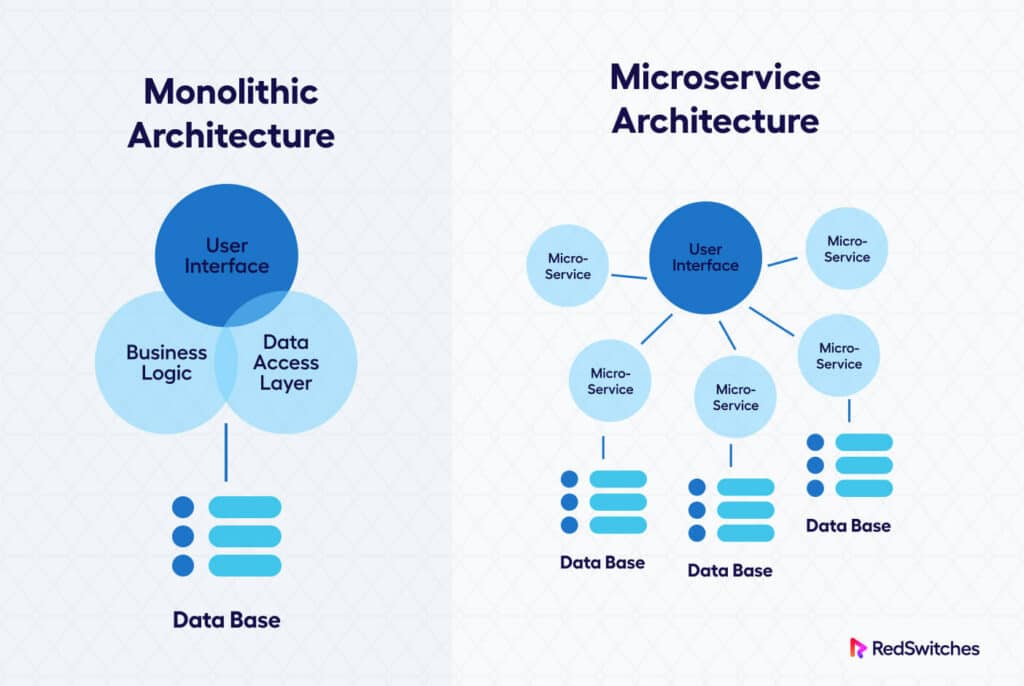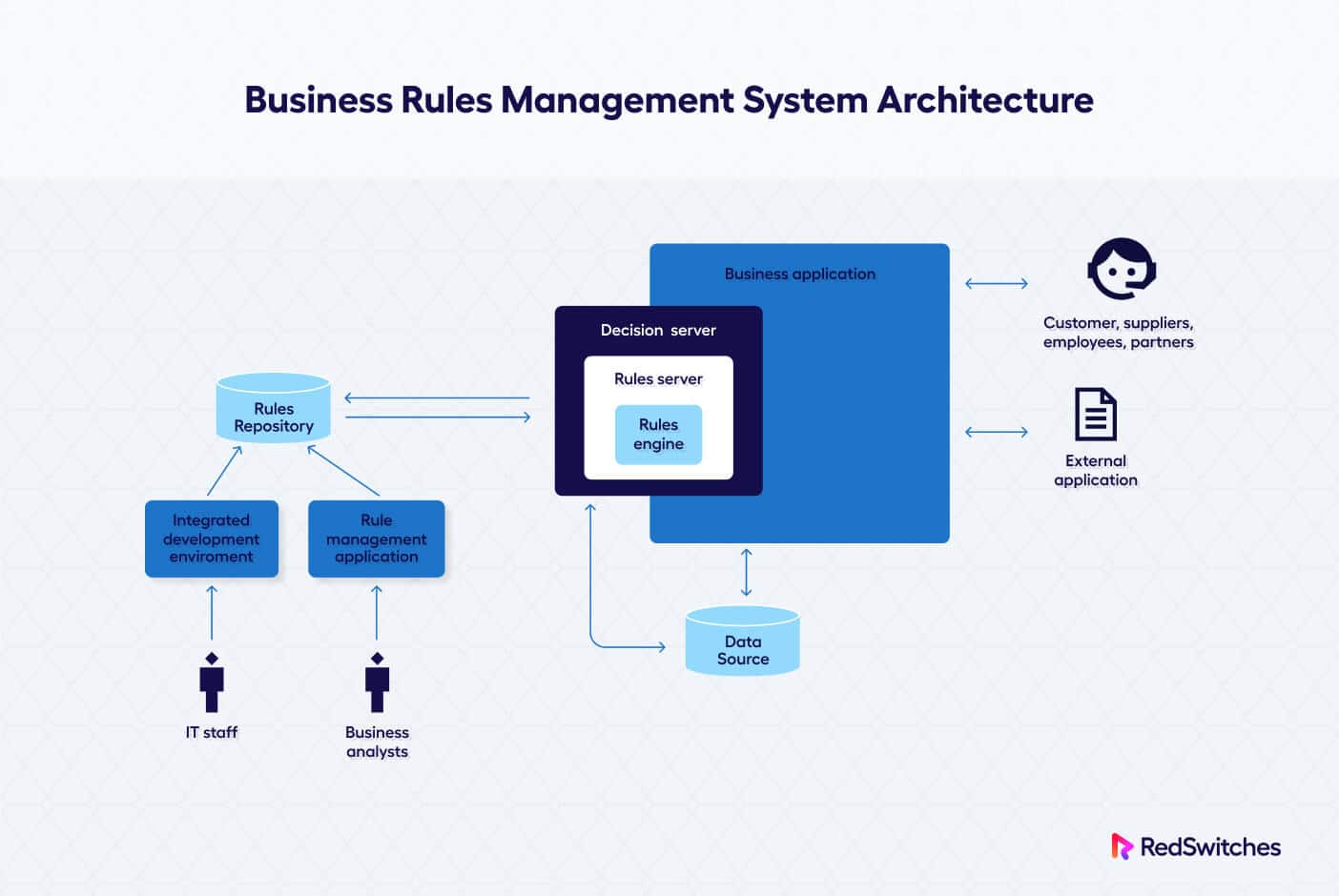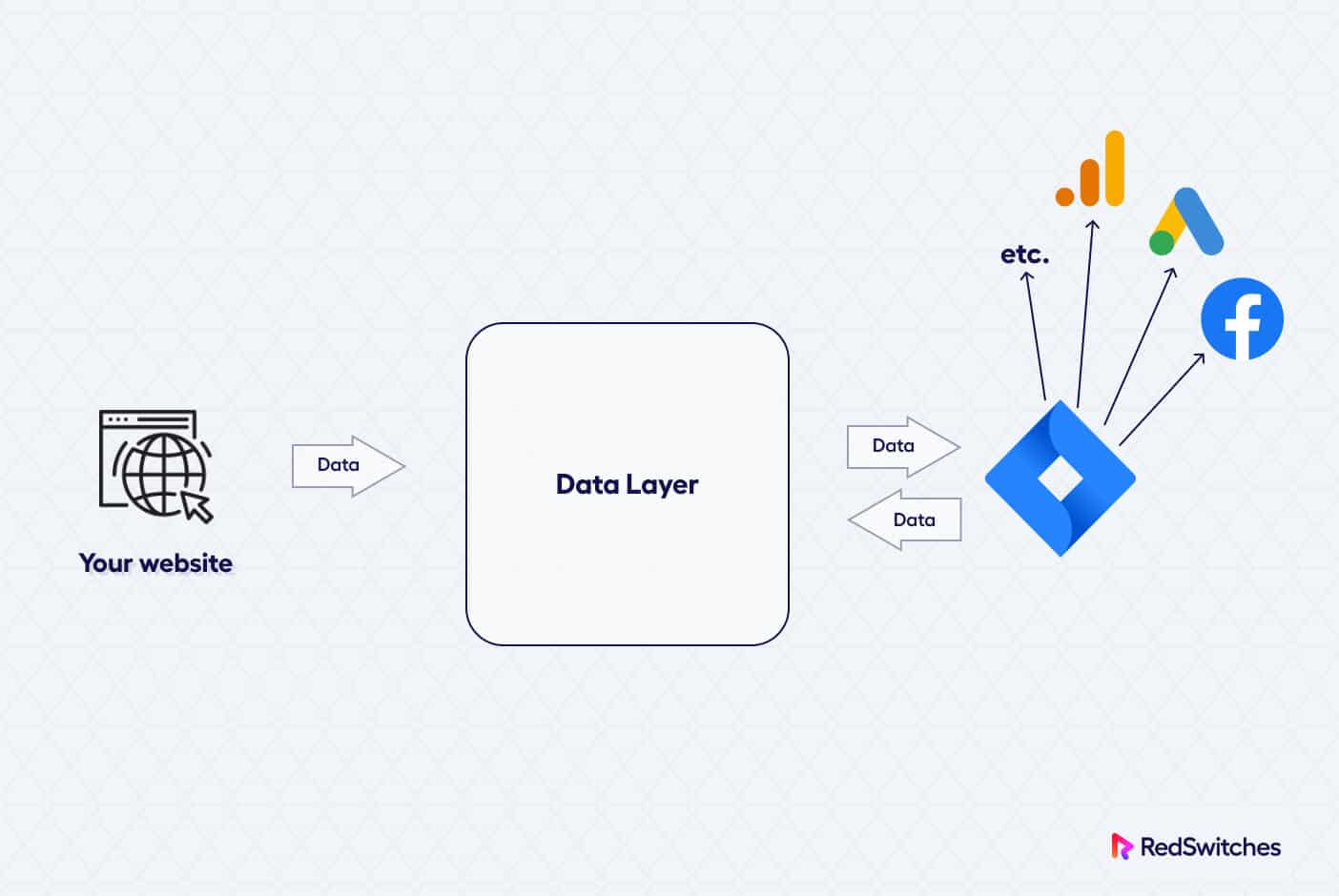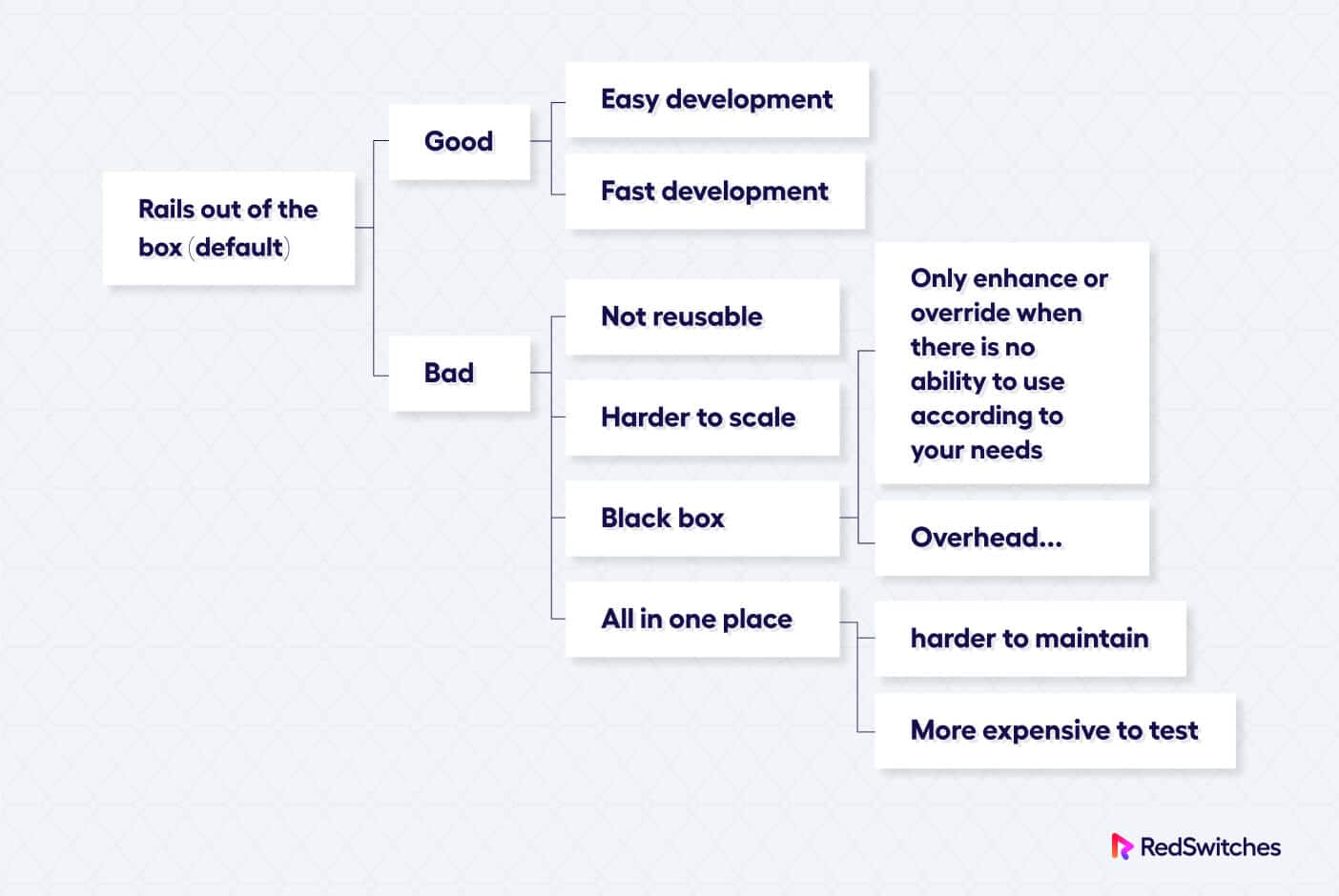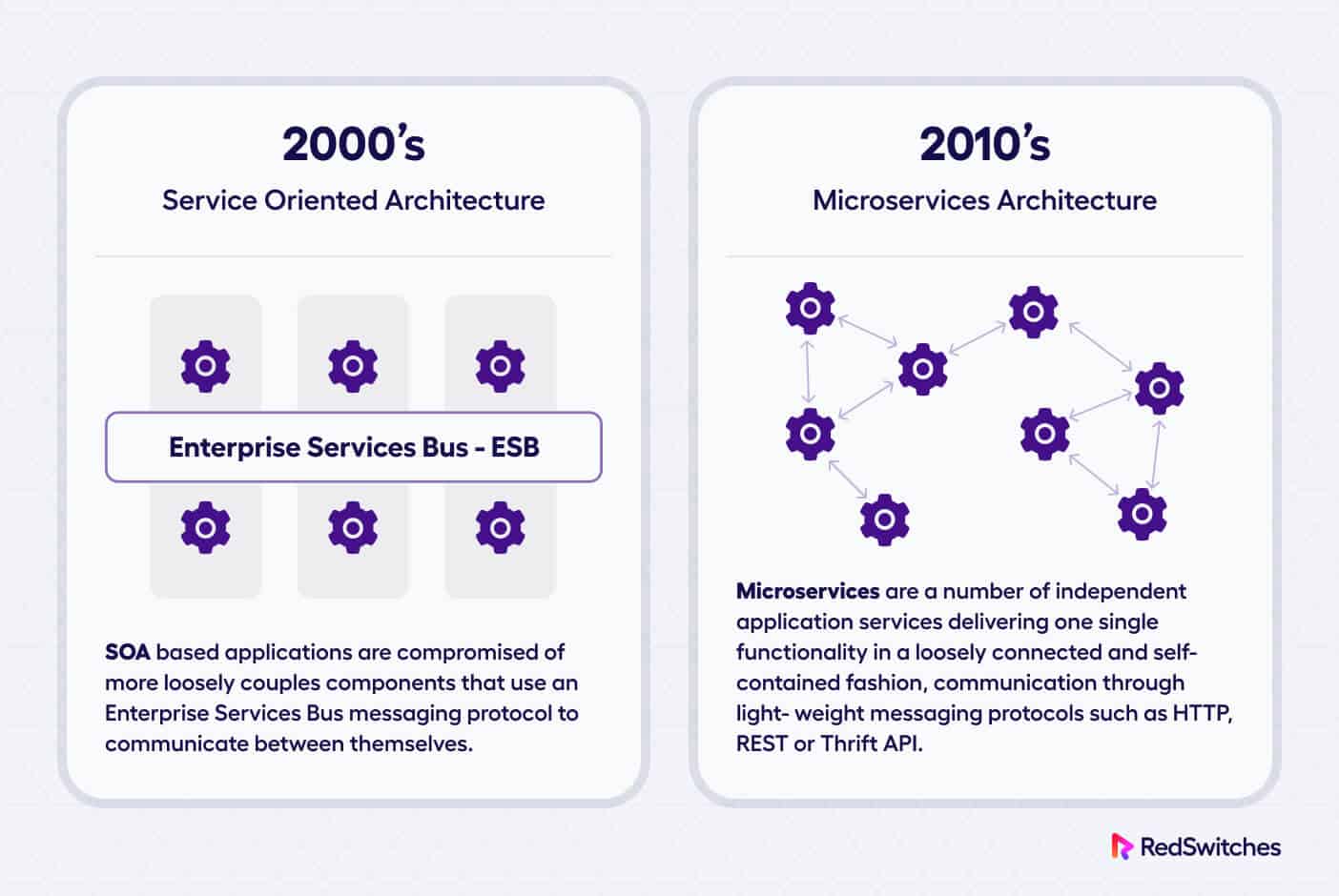The monolith vs microservices architecture debate has been happening in the software development industry for many years.
While the monolith model used to have a lot of fans, microservices have evolved beyond the fad stage and are now considered an advanced architecture option.
The number of businesses implementing microservices grows yearly, with Uber, Netflix, and Payoneer among the most notable. It has become a standard development architecture for high-traffic and high-performance applications.
However, while many experts consider monolithic architecture no longer suitable for all projects, it’s still a great option in some use cases.
In this post, we’ll look at the critical points in the benefits of the monolith vs microservices debate, the benefits of each approach, and the use cases that validate using one software design strategy over the other.
Table Of Content
- What is Monolithic Architecture?
- User interface
- Model
- View
- Controller
- Business Logic
- Data Layer
- What Is Microservices Architecture?
- Difference Between SOA and Microservices
- Monolith vs Microservices: Use Cases
- Conclusion
What is Monolithic Architecture?
A monolithic architecture is a standard method of developing software.
If you dig deep enough, you can find a lot of intricacies in monolith design methodology. However, we’ll discuss three main points – the user interface, the business logic, and the data access.
It is interesting to note that these three components exist in a strict hierarchy. You cannot consider them as separate “services”. That is one of the defining points in the monolith vs microservices debate. In a monolith design, there is a single codebase and data layer for the whole application.
Significant Components of Monolith Architecture
A monolithic application has the following major components:
User interface
This component of the monolith architecture is in charge of the software’s interface. It interacts with users and collects their input for further processing at the lower layers.
This is where we want to mention an exciting point in the monolith vs microservices debate. Both can use the Model-View-Controller (MVC) model. Let’s dive into the details of the model.
Model
This component contains the data that will be shown on the user interface. The Model also keeps the user’s personal information, account information, and settings. This data is frequently saved in the field text object rather than the database for faster access.
View
This component is in charge of displaying the model’s data. It controls the data’s location, aesthetics, and user interactions. View renders user controls, takes inputs, and responds to actions and outputs.
Controller
This component is in charge of connecting the Model and The View. It is in charge of monitoring the activities of the View, making update requests, and handling data storage.
The Controller’s responsible for ensuring that information is sent to the model.
Business Logic
This monolithic architectural component is responsible for interactions between business objects and the techniques for handling and modifying them. Business logic outlines the process of completing specific practical tasks.
Business logic deals with actual business items such as inventory, loans, and accounts. The application’s business logic determines whether a function is beneficial (in the sense that it accomplishes a specific business task).
Let’s look at a few examples to get a better idea:
- The user should be notified after completing the order.
- All registered users on the website should have access to a demo version of the service.
- A specific commission is applied to certain financial transactions.
- Users must confirm their registration through email.
These specifications constitute business logic because they link technological standards to commercial and financial goals.
Data Layer
The data layer defines the rules and procedures for storing, accessing, processing, and transmitting data. It contains a database as well as a database management system. This component of a monolithic architecture is intended to provide information to all other components.
More specifically, the monolithic data layer defines processing procedures, usage requirements, conditions, and security. If there are issues at the data layer, you’ll find issues such as lower performance, data leakage, and the inability to handle many requests and store critical data.
When is Monolithic Architecture a Good Fit for Your Projects?
The following are some scenarios where using monolith architecture makes a lot of sense.
- A single cohesive team that has been working on a project for a long time.
- The software is simple and can neatly use the MVC framework.
- The team is limited, and developers cannot specialize and design a services-based application infrastructure.
- The main priorities are the project’s delivery speed and low overall costs.
Advantages of Monolithic Architecture Over Microservices
Let’s see the benefits of monolithic architecture that the fans love to cite in the monolith vs microservices debate.
- The application is viewed as a whole during the development process and broken down only into necessary layers. There is no need for an excessive modular approach.
- It is a commonly-known technique in software development. Most tools, frameworks, and teaching materials are still designed for monolith software development approaches.
- A small dev team can easily use the approach to build a small to medium-sized project.
Disadvantages of Monolithic Architecture
Over the years, many experts have identified the following inefficiencies in the monolithic software development approach:
- The application’s features and levels are all interconnected. This coupled functionality means the entire codebase may be affected if one component fails.
- The code contains several dependencies and integrations that may reduce reusability. Features are frequently only available in conjunction with others.
- When developers add a new feature, they must change the entire application structure. This minimum support for application scalability could influence the future of the product.
- It violates the Single Responsibility Principle, which states that each component is accountable for its execution. Each element should be contained within its module or class. Because a monolith design does not segregate features, there is no single point of contact between internal components.
- A monolithic architecture must be tested and upgraded as a whole. Instead of focusing on a single feature, developers must always return to the entire source code to ensure the change doesn’t cause undesirable modifications. This is a significant point in the microservices vs monolith debate.
What Is Microservices Architecture?
In the monolith vs microservices debate, you’ll find that the microservices architecture has a huge following.
That’s because microservices are considered a solution to the problems caused by monolith software development.
In this architecture, the code is divided into distinct modules, with each feature having its distinct service. Each component of the software is dedicated to a specific function.
By definition, microservices are small and can work as separate (often standalone) tools and can even be put on the server as an isolated service.
To build software using microservices architecture, developers must decentralize functionality by splitting it into hundreds of isolated modules. There is no apparent hierarchy, and all services can function autonomously.
Cloud and serverless computing are frequently used in a microservice architecture. Microservices are commonly contained in containers for maximum isolation and simplicity of development. Docker is a popular option for deploying and managing microservices-based applications.
Properties of Microservices
In the monolith vs microservices debate, the following points are often cited by the microservices proponents:
- Microservices are self-contained services that can interact with one another and external services.
- Developers often create microservices separately and can utilize distinct technology stacks for each service.
- Developers can use a single microservice to support a single business operation.
- When upgrading a service, developers can change a single feature without affecting the entire infrastructure.
- Depending on the objective of the service, developers are allowed to employ alternative hardware and DBMS choices.
When are Microservices a Good Fit for Your Projects?
Here are a few scenarios where microservices architecture brings many benefits to the project.
- The platform must be very scalable and extend into many niches and markets.
- The product is built around cutting-edge technologies. The project scope includes ideas such as AI, ML, and IoT.
- A team of developers employs several technology stacks and tools and independently works on the services and features that make up the project.
- The business aims to immediately prevent technical debt by writing clean, understandable code.
- The organization has the right technical skills to create microservices. This often means developers who can build components that can operate independently as a microservice.
- The business places a premium on long-term gains above short-term gains.
Advantages of Microservices
Unsurprisingly, the microservices architecture’s benefits are closely related to the shortcomings of the monolith. Many issues that popped up in the monolithic way of building software were resolved using microservices. In the microservices vs monolith debate, you’ll find that the following pointers are quoted in favor of using a microservices architecture.
- Developers working in the microservice development process are not required to study the nuances of every product element. This is a crucial advantage for large, scalable projects when teams cannot track hundreds of functions.
- Microservices communicate with one another but are not dependent on one another. If one of the services fails, the others can be expanded or a new service can be added to take up the slack. Other components in this design can pick up where the failed components left off.
- Microservices can scale rapidly and efficiently. Developers can add a new service to a platform anytime and use popular protocols such as HTTP or gRPC for rapid deployment.
- Developers are no longer required to use the same solution to maintain a unified tech stack. They can choose technologies that best meet the demands of particular services in microservices, mixing multiple languages, frameworks, and integrations.
- Developers form groups of 3-5 persons, each in charge of 1-2 microservices.
- Because a new vendor does not need to grasp the complexities of current functionality, product owners can welcome outsourcing teams to join a project anytime.
Disadvantages of Microservices
In the monolith vs microservices debate, the latter is often seen as the clear winner. Microservice architecture is fantastic, but it is not without its flaws. Let’s look at the issues that most teams confront when working with microservices methodology.
- Teams need to change their mindset. Changes must be done at the development level and management, communication, and onboarding levels.
- Designers need to invest in modularization of functionality. Before creating a service, developers must choose how to divide the entire functionality into modules. The software will be exposed to operational and security issues if done incorrectly.
- Teams must communicate effectively. Although microservices development implies excellent flexibility, it also requires teams to provide regular status reports and keep track of overall workloads.
- Different technology stacks make automation difficult. You need to locate appropriate tools for various languages and runtime environments. Automation is sometimes impossible because of a severe mismatch between services.
The microservices architecture demands a fresh approach to development and process management. By using microservices, the organization agrees to a shift in work methods and priorities. Establishing a system in-house might be complex, but collaborating with off-shore developers is easier.
Difference Between SOA and Microservices
The concept of breaking down architecture into components has existed for some time. Before the popularity of microservices, we had service-oriented architecture (SOA). The two ideas are very similar but have a few crucial distinctions.
A service-oriented architecture is a modular method of developing software. It comprises loosely linked components that communicate with one another using protocols.
According to this definition, SOA may appear synonymous with microservices. However, as you go into the details, the differences become apparent.
- Business functions determine every service in SOA. This is the basis for various distinctions between SOA and microservices. Business jobs vary in size – verifying an order is more straightforward than writing a company agreement. As a result, the complexity of SOA services varies.
- SOAs are capable of doing numerous jobs in one module. You can lower the number of components, but the system will not perform as well if one component fails.
- Components share information. Microservices are designed to share as little information as possible, whereas SOA components reuse the same code. SOA services are often slower in execution but require less time to be up and running.
Is SOA a monolith? No, because the architecture is divided into modules. In some ways, it may be described as a hybrid of monolithic architecture and microservices.
Monolith vs Microservices: Use Cases
Small teams working time and budget limitations can handle monolithic application development projects. With its rapid code production phases, monolith development methodology allows the units to accomplish more early on. Here is a collection of projects that benefit from the monolith model.
- Small services: If you’re making a small app, there’s no reason to divide it down any further.
- Minimal viable products: Because it is faster and less expensive, developers may create a proof of idea as monoliths.
- Enterprise sites: Websites with the primary goal of giving business information do not need a comprehensive collection of capabilities. They can be readily created as a monolith because they don’t need extensive scalability in the future.
Microservices, on the other hand, are more expensive and time-consuming in the early phases of development. They are a long-term investment, and the businesses save money and effort as the project grows. This leads to the following architectural use cases.
- Platforms that need to be scaled: Microservices are great for building projects such as complicated online portals or mobile applications that span various specialties, focus on different marketplaces, or cater to millions of users.
- You have a large dev team: Microservices-based projects are a good fit if you have a large team. You can assign various services to different teams to speed up the development timeframe.
- Cross-platform apps: A reusable codebase (such as that preferred by microservices architecture) is essential if your solution is intended to support web, desktop, and mobile platforms. Microservice architecture is a better alternative for cross-platform solutions.
- Real-time applications: Microservices may be more suitable for the task if the program manages a large amount of data and must process tens of thousands of concurrent user requests.
Conclusion
We presented the significant points of the monolith vs microservices debate.
The outcome of this debate is that monolithic architecture is an excellent alternative for mid-sized projects that must be completed swiftly and on time. It is simple to design and maintainable by a small team, and the architecture’s intuitiveness allows for rapid progress.
Scalability is a crucial consideration in favor of microservice design. It’s an excellent choice for large platforms, complicated corporate applications, and growing enterprises. This design methodology eases the development process for an ambitious product with quick scalability when you need it.
Whether your project is a monolith application or uses a combination of microservices, RedSwitches has the right bare metal dedicated server for hosting it. Our experts are always there to help you set up the server for your projects.
FAQs
Q. Why is it easier to maintain a Microservice than a Monolithic application?
Because a microservices architecture comprises pieces that function separately, each service may be built, updated, deployed, and scaled without impacting the others. Software upgrades may be made more often, improving dependability, uptime, and performance.
Q. How do you communicate between services in a Microservices architecture?
To achieve consistency, you can use any protocol to transmit and propagate data asynchronously among microservices. You can opt for integration events via an event bus or message broker or use HTTP by polling other services.
Q. What is the reliability of Monolithic architecture?
A monolith comprises only one server where all calls and processing take place. In other words, if this server or associated network fails, the entire software will be rendered inoperable. On the other hand, network calls from microservices are 99.9% reliable because of their distributed nature.
Q. How is load balancing done in Microservices?
Load balancing in a microservices architecture is divided into server-side load balancing and client-side load balancing. Server-side load balancing employs the traditional load balancing strategy, in which traffic is spread via a load distributor positioned in front of the servers.
